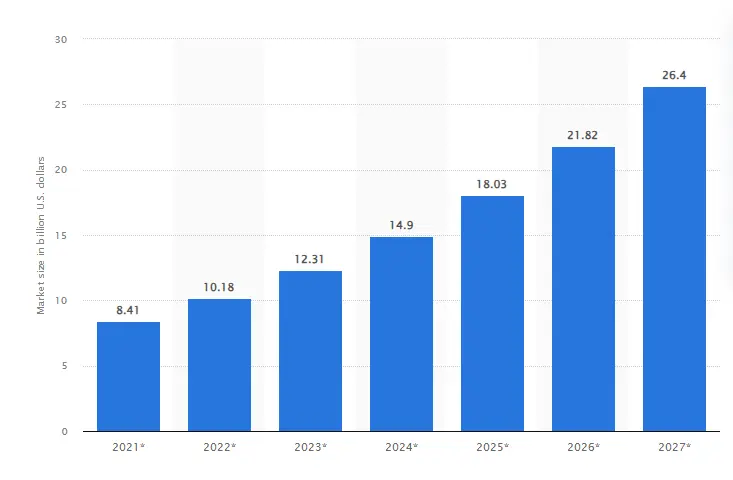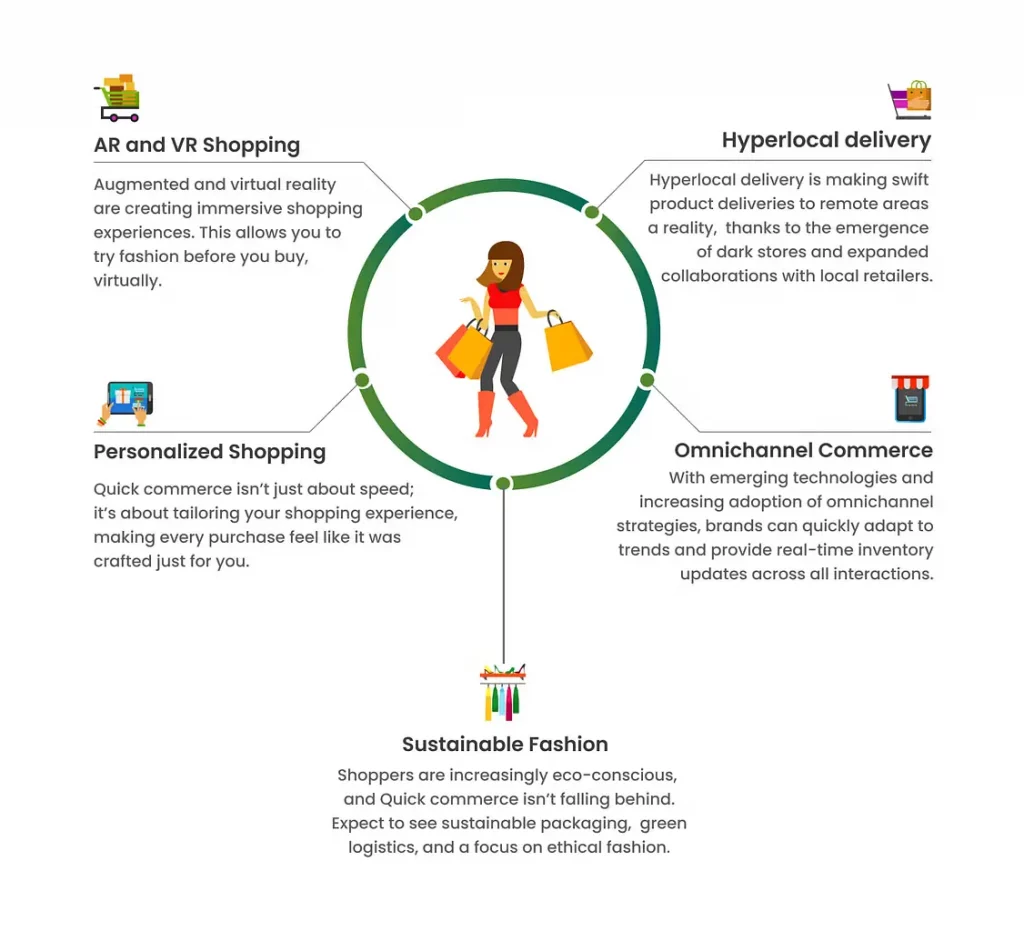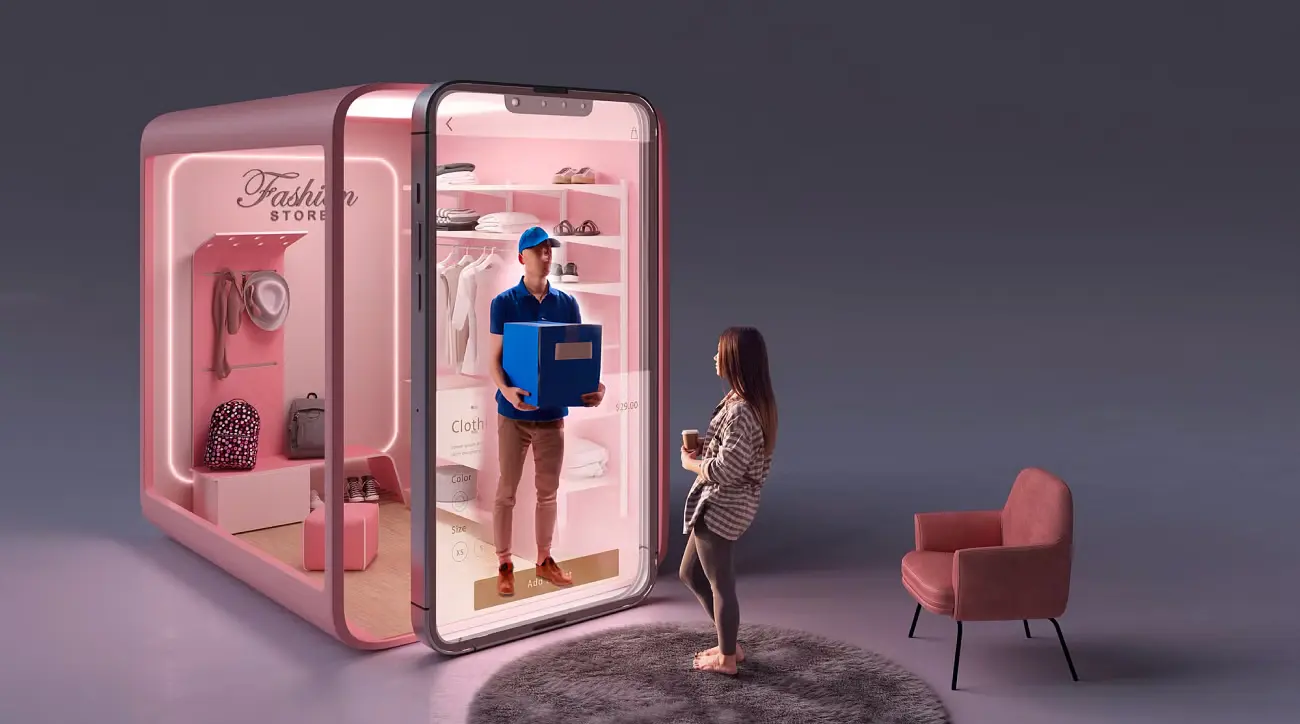Imagine you’re all set for a function or a cozy get-together with your old-school pals, and suddenly it hits you that your outfit needs some tweak. Time’s ticking; can you make it to the store in time?
Your initial instinct would be to check your wardrobe, hoping to find that perfect combination of clothing and accessories that can salvage the situation. If quite the opposite, Plan B is online shopping.
But here’s the twist, how soon can your style be at your doorstep?
That’s where quick commerce companies may step in, serving as your lifeline when you need a swift fashion fix.
Let’s explore how this revolutionary shopping model is driving the digital transformation in fashion retail, transforming on-demand shopping trends, and sparking excitement in the fashion retail sector.
Brief Overview of the Fashion Retail Industry
Fashion retail is a dynamic and ever-evolving sector that thrives on new ideas, creativity, and customer preferences to satisfy people’s desire to wear what they like. In this business, most retailers don’t have their own manufacturing units. Instead, they curate customized collections of the latest fashion by buying them from different manufacturers and selling them to consumers.
Traditionally, fashion retailers have been characterized by physical stores and seasonal collections. However, it has evolved a lot over time, modernizing society, from how our ancestors dressed to how we perceive fashion now. Thanks to the strategic thinkers and designers who looked at fashion from different angles, like what people want to buy, what other stores are doing, and what’s in style now and many more.
But now, things are changing, as eCommerce and quick commerce gain traction in retail with digital transformation. You can buy clothes from your couch, anytime you want. It’s in a way enhancing customer satisfaction by offering quicker access to the latest collections, where trends change rapidly and styles become outdated.
But here’s the big question: Is quick commerce, the fastest delivery model, really practical with all the supply chain challenges and transformations happening in the fashion industry? Let’s try to figure this out as we keep up with the fast-changing world of fashion.
Emergence and Importance of Quick Commerce Solutions
Quick commerce or q-commerce is an emerging lightning-fast delivery model, promising you to get your orders delivered within hours, sometimes minutes. This model took its form globally in late 2021 due to changing consumer expectations, increasing eCommerce penetration, and the rise of omnichannel marketing.
A survey conducted by Statista revealed that 70% of consumers in the United States expect same-day delivery options while making online purchases. Moreover, in its worldwide survey, the global same-day delivery market is projected to rise to 26.4 billion USD by 2027.

But it’s not only speed that matters; flexibility matters too.
We witnessed highly vulnerable supply chains during COVID-19, which however managed to survive, even with the instant and on-demand deliveries expectations. This resilience paved the way for quick commerce, a robust solution, placing immediacy at its core. It swiftly adjusted to challenges, while ensuring we get our essential items faster and cheaper. Some of the major players dominating the world of quick commerce are Gorillas, Flink, Getir, Gopuff, Amazon, Blinkit, Flipkart Quick and more.
These quick commerce companies excelled in faster delivery as they
- Partnered with rapid courier services
- Implemented fast bike delivery systems
- Strategically allocated dark stores
- Implemented location-mapping technology
- Promoted small shop-centric swift delivery
- Efficiently managed inventories
- Refined existing supply chain infrastructure
Veppy.com, one of the first quick commerce marketplace startups in UAE, has opened new avenues of opportunities for suppliers and sellers. Its Founder and Chairman, Moustafa Banbouk, says,
“Veppy.com is offering a golden opportunity for small and medium enterprises (SMEs) as well as large suppliers to register with us and list their products within these specified categories so that consumers could purchase them through Veppy.com. It gives wholesalers, retailers, and SMEs an opportunity to grow their business through us and also offers consumers a wider choice to shop online with value-added services”
– Moustafa Banbouk, Founder and Chairman.
In the near future, amidst the digital transformations in the fashion retail sector, this promising delivery solution is going to be a game-changing trend. It will allow the quick commerce market to push even further boundaries, reshaping the way we shop and receive goods in the digital age.
If you are an eCommerce retailer and haven’t implemented quick commerce yet, it’s time that you adopt this model to enhance your competitive USP and achieve these benefits.
Quick Commerce Challenges Faced by the Fashion Retail Industry

Quick commerce is expected to undergo substantial expansion between the financial years 2022 to 2027, with a forecasted Compound Annual Growth Rate (CAGR) of 17.44%. However, when it comes to the fashion industry, quick commerce faces some unique challenges that make its adoption a bit tricky. Also, there aren’t many eCommerce players globally who have given a thought to it because of its underlying complexities and cost overhead.
Here are some of the critical challenges that fashion retailers need to overcome while delivering quick commerce solutions:
Supply Chain Complexity
Fashion retailers often have to ensure that they have a robust supply chain system capable of reaching even the remotest areas. And, in quick commerce with faster delivery expectations, the resilience of these supply chains becomes an even more critical factor, increasing its complexity.
Fluctuating Consumer Behaviour
Consumer preferences are often unpredictable. Predicting what customers will want next to satisfy their sudden fashion impulses and having those items in stock for quick delivery can be a real challenge for fashion retailers.
Inventory Management
Sometimes, millennials may have different preferences from Gen Z. Maintaining the optimal inventory levels of fashion items for each customer base is vital for quick commerce. Having too much inventory can tie up your capital while having too little can lead to missed sales opportunities. Fashion retailers must strike a delicate balance to avoid overstocking or understocking.
High Return Rates
While buying fashion online, returns are common due to size or style issues. Quick commerce amplifies this challenge, as customers expect speedy returns and refunds. Fashion retailers must have efficient return processes in place to be successful in quick commerce delivery.
Sustainability Concerns
Quick commerce, being a direct-to-consumer business model, gives rise to several sustainability concerns like faster deliveries, product returns, driver wages, operational costs, and outdated fashion trends. These factors, in one way or the other, can result in significant environmental impacts.
Sustainability vs Speed in Quick Commerce
Ever since the quick commerce market emerged, retailers have been employing strategies like discounts and 30-minute delivery to boost eCommerce adoption, all while staying trendy in their offerings. Yet, the question that remains: Is quick commerce both profitable and sustainable?
The only way quick commerce can dominate the fashion retail industry and remain profitable is by maintaining a linear curve, balancing sustainability with speed. This of course requires innovative solutions like eco-friendly packaging and energy-efficient delivery methods. But, it also requires earning additional value from incoming orders.
One viable approach for quick commerce companies is to fix minimum order values or order quantities to qualify for quick deliveries.
Secondly, working on wholesale margin can expand their reach. Companies can partner with more private brands, and boutiques, and establish direct relationships with key manufacturers and delivery partners. Take, for instance, Tesco’s Whoosh, in collaboration with Gorillas, is now excelling in rapid deliveries reaching over 55% of UK consumers from over 1000 Tesco Express Stores.
The Future of Fashion Retail and Quick Commerce
Quick commerce, with its promise of instantly gratifying your needs, is leading the charge in fashion retail. In the current scenario, it is evident that the fusion of fashion and technology is redefining the way we shop.
Here are some of the compelling trends awaiting us in the future of quick commerce,

Further, the boom in online shopping and expanding network of online retailers and delivery platforms is increasing the adoption of digital technologies such as AI and automation. Now, you can streamline supply chains, efficiently manage inventories, and communicate with AI-driven chatbots and virtual stylists, all at your fingertips to help you navigate through the latest fashion trends. Clearly, the future of quick commerce in the fashion space has a wide potential for growth.
The problem, however, is that this may not be feasible for small companies who are trying to jump on the quick commerce bandwagon, at least until delivery speed becomes the top priority for consumers. For instance, Flipkart has streamlined its “Flipkart Quick” services, reducing its presence from 14 cities to just 2, with a newfound focus on integrating it with the next-day delivery platform, Flipkart Supermarket. Similarly, Ola Dash entered the q-commerce arena with ambitious plans to launch over 500 dark stores in 20 cities but had to suspend scaling operations due to declining demand and rising operational costs.
Conclusion
At its core, the success of quick commerce in the fashion industry depends on retailers’ agility in adapting to evolving customer preferences. While blending innovation, style, and technology, it also has to face unique challenges related to swift deliveries and complex supply chain networks. Yet, its future seems promising with the rise in brand-conscious and fashion-savvy consumers demanding same-day deliveries.










